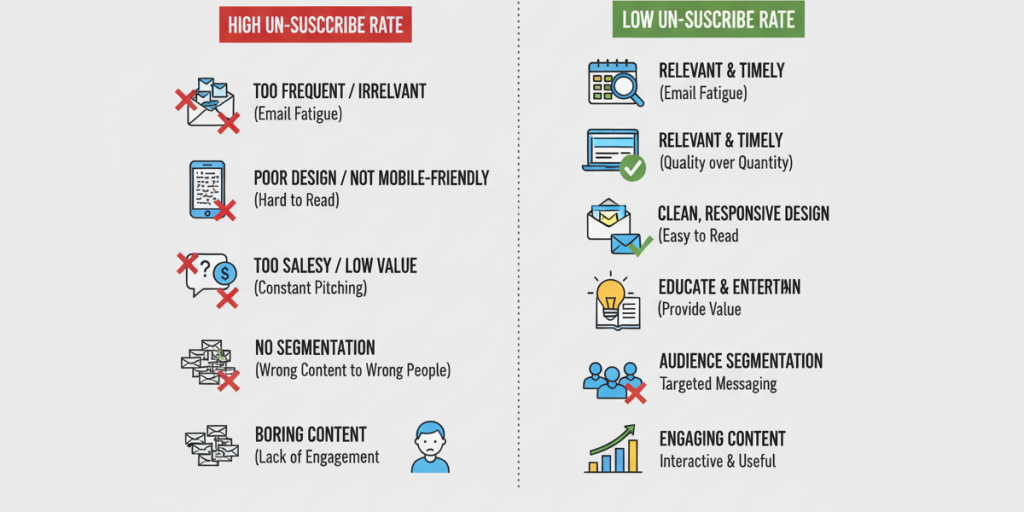Every unsubscribe stings, but what if each departure could teach you how to better serve your remaining audience? Most creators miss the golden opportunity to learn from unsubscribes, leaving valuable feedback untapped. The secret isn't preventing all unsubscribes—it's learning from them to reduce future churn and improve content quality.
The Real Reasons People Unsubscribe (It's Usually Not Personal)
Understanding why people leave is the first step toward reducing unsubscribe rates. Most reasons have nothing to do with content quality and everything to do with fit and expectations.
Top 5 Unsubscribe Reasons
- • Frequency mismatch - Too many or too few emails
- • Content relevance - Topics no longer match interests
- • Inbox overload - General email cleanup
- • Expectation gap - Content different than promised
- • Life changes - Job, interests, or priorities shifted
The Painless Exit Survey: Turning Goodbyes into Gold
Instead of a simple unsubscribe confirmation, implement a gentle exit survey that respects the subscriber's decision while gathering crucial feedback.
The One-Question Exit Survey
Keep it simple and respectful. One well-crafted question gets higher response rates than complex surveys.
Implementation:
"We're sorry to see you go! To help us improve, could you briefly share why you're unsubscribing?"
Multiple Choice with "Other" Option
Provide common reasons as options while leaving room for unique feedback.
Options to Include:
- • Getting too many emails
- • Content isn't what I expected
- • Not relevant to my current needs
- • Other (please specify)
The Alternative Offer Approach
Before they leave entirely, offer alternatives that might better suit their needs.
Implementation:
"Instead of unsubscribing completely, would you prefer: Fewer emails? Different topics? A digest version?"
Exit Survey Best Practices
✅ Do This
- • Keep it to one screen or less
- • Use respectful, grateful language
- • Make unsubscribing easy (no hidden buttons)
- • Offer real alternatives when possible
❌ Avoid This
- • Long, complicated surveys
- • Guilt-tripping language
- • Making unsubscribe difficult
- • Required feedback to unsubscribe
Analyzing Exit Feedback: Patterns to Watch For
Quantitative Analysis
- • Frequency complaints - Adjust sending schedule
- • Topic patterns - Identify weak content areas
- • Timing trends - Note when unsubscribes spike
Qualitative Insights
- • Specific complaints - Address recurring issues
- • Suggestions - Implement popular requests
- • Tone analysis - Gauge emotional response
Proactive Feedback Collection (Before They Leave)
Regular Content Satisfaction Surveys
Check in with engaged subscribers before they become disengaged.
Example: "How are you enjoying our content? What would make it more valuable for you?" Send to active subscribers every 3-6 months.
Preference Center Updates
Make it easy for subscribers to adjust their experience without leaving.
Options to Offer: Frequency preferences, topic selections, digest vs. individual emails, pause subscriptions temporarily.
Re-engagement Campaigns
Reach out to disengaged subscribers before they unsubscribe.
Strategy: "We noticed you haven't been opening our emails lately. Would you like to: Update preferences? See our most popular content? Take a break?"
Turning Feedback into Actionable Improvements
Content Adjustments
- • Add requested topics to editorial calendar
- • Reduce coverage of unpopular topics
- • Adjust content depth based on feedback
- • Improve content formatting and readability
Delivery Optimizations
- • Adjust sending frequency based on preferences
- • Optimize send times for better engagement
- • Create different subscription tiers
- • Improve subject line clarity and accuracy
Measuring the Impact of Feedback-Driven Changes
Engagement Metrics
- • Reduced unsubscribe rate
- • Improved open and click rates
- • Increased reply rates
Retention Metrics
- • Longer subscriber lifespan
- • Higher re-engagement success
- • Reduced spam complaints
Business Metrics
- • Higher conversion rates
- • Increased referral traffic
- • Better sender reputation
Creating a Feedback-Friendly Culture
Normalize Feedback Collection
Make feedback requests a regular part of your newsletter strategy, not just something that happens when people leave.
Act on the Feedback You Receive
When subscribers see their suggestions implemented, they feel heard and valued, increasing loyalty.
Share What You Learn
Occasionally share with your audience how their feedback has shaped your content. This builds trust and encourages more input.
Every Unsubscribe is a Learning Opportunity
The most successful newsletter creators don't fear unsubscribes—they learn from them. By implementing painless feedback collection systems, you transform departures into valuable data that helps you serve your remaining audience better.
Remember that some unsubscribes are inevitable and even healthy for your list. The goal isn't zero unsubscribes—it's continuous improvement based on real audience feedback. By making it easy for subscribers to tell you why they're leaving and what would make them stay, you create a virtuous cycle of improvement that benefits everyone who remains on your list.


